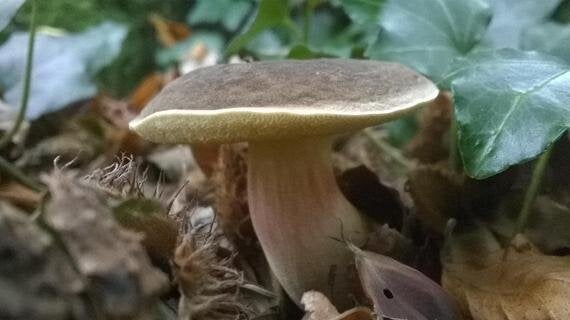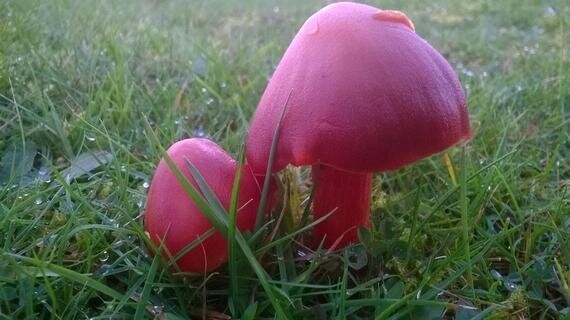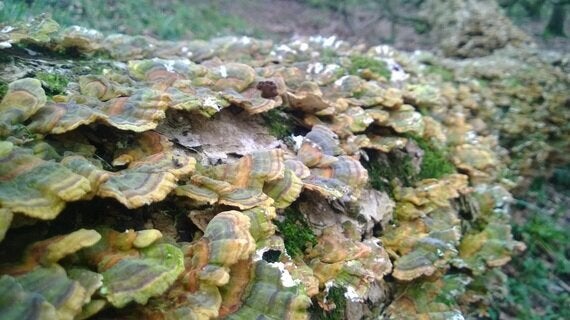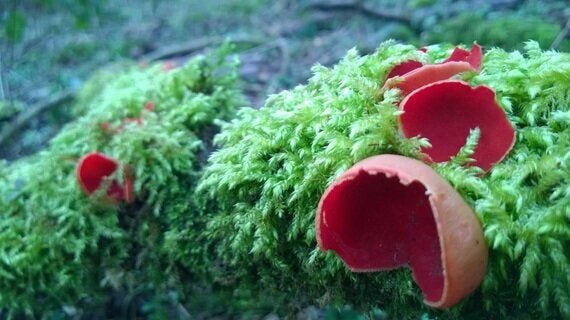I was recently taking a break while working alone in the woods, it was completely silent and still. Suddenly, the whole area of 'just trees' became alive - a wren started foraging in front of me, a robin starting singing to me from about a metre away. The ground started to move - a woodlouse was trekking to destination unknown. Then I spotted a fungus in front of me - brown and rounded and juicy looking, but it was MOVING. Being deeply confused and starting to question my own knowledge of the kingdoms of life, sensory perception and locomotion in not-animal organisms, I moved closer with some trepidation. What was this strange being from another world? What stories could it tell me of other planets, other universes?
It was a slug, happily munching away on a nice bit of bolete. But there was an alien there - the fungus itself.

Boletes reticulatus, possibly!
Fungi are an oft-overlooked feature of the countryside. Let's face it - they are small, brown and mushy and may kill you if you try to eat them. Fungal forays with National Trust are extremely popular, as is any foraging event - question 1 about any fungus is 'what is it?' Question two is always 'can I eat it?' Aside from cautioning against randomly eating anything, putting your trust in another person identifying it for you also seems fairly risky.
Fungi are so much more than just something to be eaten in a spaghetti bolognaise. Next time you see fungi, say a lovely waxcap lawn covered in the archetypal 'toadstools', don't just look at the pinks, scarlets, greens, yellows and snow whites. Have a feel of them too - some are bone dry, some a bit waxy or super slimy. Give them a sniff (don't be scared!), you might smell honey, flowers or old pencils. Some might even be mimicking the scent of flowers. We love birds for the way they look and how they sing, as they appeal to more than one of our senses - so do fungi.

Hygrocybe punicea (crimon waxcap): a very stylish fairy umbrella
Maybe you haven't seen a waxcap - if not, come to Llanerchaeron and see them on our lawn or on the coast in Ceredigion. They are easy to miss if you are not staring at the ground, but once you get your eye in you will see loads of them. It's sad to think that before the advent of pesticide and fertilizer use on an industrial scale, there would have been lots of these wherever there is short turf, whether on the wind lashed coast or lawns full of mosses and different grasses.
Fungi are providing us with so much, breaking down the lignin of a tree to 'recycle' its skeleton, creating holes in them by removing cellulose or feeding on cow pats. They can provide shelter for some species (and fairies of course) or attack crops. There's no doubt fungi are incredibly alien to us - perhaps more so than the plant kingdom. Maybe you've heard about leafcutter ants growing fungi for food, or the other species that turns ants into zombies, controlling their behaviour and growing out of their brain. We have Cordyceps militaris right here, feeding on insect larvae under the soil. 'Mushrooms and toadstools' can grow in seasonal turkey tail or Christmas decoration shapes, or look like cyber punks, a cage, a coral, a delicate ruffle or your weird pier cap on your wall. They can also lower the tone by being called Phallus impactus and looking a bit...odd.

Trametes versicolor recycling an old tree
You may have heard the recent stories about some of New Forest, areas of which are managed by National Trust. Roving 'gangs' stripping the woods of chantarelles and ceps. Aside from a less loaded word such as 'group' being more appropriate, I was struck by the assumption that this was damaging the fungus itself. Some experts believe it rarely does as the fungus itself is loosely more of a fruiting body such as a nut or flower - the rest of the organism is many, many times larger and growing under the soil. Others believe it can do huge damage - so the jury's out, and therefore it's best to err on the side of caution. After all, trampling is another action that could be having a huge effect under the soil. Damage is still occurring in industrial scale picking for restaurants, depriving everyone else visiting that area of their beauty. Foraging can also remove an element of the ecosystem in a very different niche to the part of the organism that is underground. In addition to fungus gnats feeding on them and spreading their spores, many invertebrates (such as our aforementioned slug) eat fungi, hopefully without a one-footed trampling effect.

Sarcoscypha austriaca, scarlet elf cups used by elves as a drinking receptacle
This is what makes nature so complex and amazing - even a fruit could be considered in a different niche to a bit of bark or some roots or the filamentous part of a fungus. And the fact is, we hardly know anything about fungi at all! Thousands of new species are just waiting to be discovered - there are many unnamed mycorrhizal fungi, all living in close association with plant roots.
Next time you are out & about, maybe at Abinger Roughs & Netley Park, perhaps just stopping and enjoying nature, have a look under your feet or at the moss on a tree trunk - you never know what you might find!
Disclaimer: Any reference to elves or fairies is all in your mind